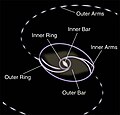NGC 6782 is a barred spiral galaxy located in the southern constellation of Pavo, at a distance of approximately 173 megalight-years from the Milky Way.[3] It was discovered on July 12, 1834 by English astronomer John Herschel. John L. E. Dreyer described it as, "considerably faint, considerably small, round, a little brighter middle, 9th magnitude star to south".[7] The morphological classification of NGC 6782 is (R1R′2)SB(r)a, indicating a barred spiral galaxy with a multiple ring system and tightly-wound spiral arms.[5] It is seen nearly face-on,[8] being inclined by an angle of 27.2°±0.2° to the line of sight from the Earth.[5]
| NGC 6781 | |
|---|---|
 A Hubble Space Telescope (HST) image of NGC 6782. | |
| Observation data (J2000 epoch) | |
| Constellation | Pavo |
| Right ascension | 19h 23m 57.935s[1] |
| Declination | −59° 55′ 21.04″[1] |
| Redshift | 0.012462±0.000123[2] |
| Heliocentric radial velocity | 3,736 km/s[3] |
| Distance | 173 Mly (53 Mpc)[3] |
| Apparent magnitude (V) | 11.8[4] |
| Characteristics | |
| Type | (R1R′2)SB(r)a[5] |
| Apparent size (V) | 1′.197 × 0′.814[1] (NIR) |
| Other designations | |
| LEDA 63168, ESO 142-1, 2MASX J19235793-5955210, NGC 6782, PGC 63168[6] | |
At the galactic core is an almost circular nuclear ring at the inner Lindblad resonance. This is attached to the primary bar, which extends out to a somewhat pointy, diamond-shaped inner ring. It is actually a double-barred galaxy, with an interior bar inside the nuclear ring. A pair of faint spiral arms extend out from the inner ring to the outer parts of the galaxy, where it joints a double outer ring system.[5] Both inner rings of the galaxy are undergoing star formation, producing hot OB stars, with little star formation occurring in the remainder.[8]
Gallery
- Structure of NGC 6782
- NGC 6782 with legacy survey
See also
- Messier 94 - a similar spiral galaxy
References
External links
 Media related to NGC 6782 at Wikimedia Commons
Media related to NGC 6782 at Wikimedia Commons- Hubble Heritage site: Pictures and description


